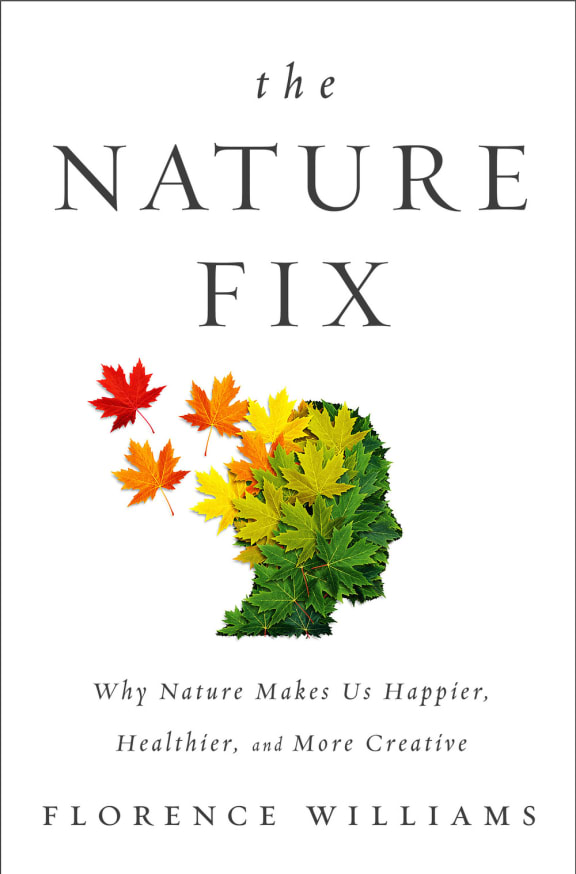
The Nature Fix book cover Photo: supplied
In an increasingly urban world, taking the time to go for a bush walk isn’t always easy, but a new book is highlighting the mental and physical benefits of getting into nature.
From increased memory to reduced heart rates and improved metal well-being, science is backing up what some people have long suspected – the health benefits of getting outside.
Those benefits and the restorative power of wild places is at the centre of US author Florence Williams’ new book, The Nature Fix: Why Nature Makes Us Happier, Healthier, and More Creative.
She told Jesse Mulligan people are spending more time inside than ever - in part due to urban environments, but also due to technology.
“Even kids who live in the country are coming home from school and playing video games.”
Williams says on average people spend 95 percent of their time indoors.
She says researchers have varying recommendations about how often people should be outside, but scientists in Finland recommend at least five hours outside a month.
“The city parks are okay and they will help you feel better, but if you really are serious about fighting depression, it’s better to be in a more naturey area with a minimum of five hours a month.”
The effects of being out in nature may also last much longer than the initial feel-good factor.
“Researchers have found that while we’re out in the woods we actually increase our immune cells and… our cancer fighting cells, really important part of our immune system, those cells seem to increase after a walk in the woods, and they don’t increase after a walk in the city.
“The effect actually lasts for a week at a pretty high level and then it tapers off but there’s still some residual effect after 21 days.”
But if getting out into the bush isn’t accessible, there’s still plenty to be gained from spending time in a park closer to town.
“If you want to maximise your kind of sense of restoration, and stress recovery, you get a much better effect if you actually try and listen to the birds, try to look at some of the patterns, for example in the trees, the leaves or the creeks, and a lot of city parks have some amazing nature features in them.”
Having grown up a few blocks from New York’s Central Park, Williams says she appreciates the effort designer Frederick Law Olmstead went to in creating features there.
“He really understood intuitively that people living in urban environments needed some beautiful elements of nature in order to recover from city living.
“So he designed things like winding pathways in his parks, you know beautiful big trees, boulders, meadows that you could look across… all these elements that really maximise a sort of sense of delight and pleasure and community even.”
Williams says Olmstead knew that being in nature makes people more civilised.
The need for nature in the urban environment has also been carefully considered in Singapore, which is the third densest city in the world.
“Since the 1960s in Singapore they’ve planted 1 million trees, they’ve developed 300 kilometres of sort of greenway cycling and hiking trails… Interestingly there are some city policies there that if you build an office tower for example, you have to more than replace the green space you’ve taken away.”
The benefits of nature are also being realised in Japan, where scientists have found that even short walks in nature can reduce blood pressure, change heart rate variability and stress rate profile.
“They’ve taken it so seriously that they’ve now designated 48 forest therapy trails… and on these trails people are really encouraged to go out and do something called ‘forest bathing’.
“It does not involve taking off all your clothes but it does just involve cueing in to all five senses and really paying attention to where you are.”
Williams says there is evidence to back up the benefits of nature and doctors are now prescribing some patients to spend time outdoors.
“These studies quite consistently find that people’s nervous systems calm down when they’re outside.”
Epidemiologists in England have also been studying the effects of nature on a wider scale with interesting results.
“How close they live to green space and measuring that against medical records and they’re actually finding that people have lower mortality levels, lower levels of stress-related diseases, the closer they live to parks, and it’s not dependent on income.”
Williams says there are a number of theories about why nature has such a positive effect on our brains, but one centres on humans’ evolution in the outdoors.
“We evolved in outdoor environments, you know, over millions of years… our sort of indoor life has been incredibly recent.”
She says we often undervalue how good nature makes us feel.
“We tend to think that shopping or streaming Netflix, that those things will make us feel really great and then we under-value how good nature makes us feel.”
For people who can’t spend as much time in nature as much as they’d like, Williams says just getting outside is a good start.
“If you can sit in a backyard, take a lunch break, you know walk a few extra bus stops along a tree-lined street, you will reap the rewards the rest of the day.”

